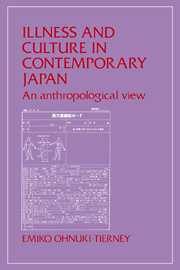Book contents
- Frontmatter
- Contents
- List of illustrations
- Acknowledgments
- 1 Introduction
- Part I Basic concepts and attitudes toward health and illness
- Part II Medical pluralism
- 5 Kanpō: Traditional Japanese medicine of Chinese origin
- 6 Medical roles of Japanese religions: A descriptive overview
- 7 Medical roles of Japanese religions: A historical-symbolic interpretation
- 8 Doctors and outpatients: Biomedicine (I)
- 9 Hospitalization: Biomedicine (II)
- 10 Medical pluralism
- Summary
- References
- Index
10 - Medical pluralism
Published online by Cambridge University Press: 12 January 2010
- Frontmatter
- Contents
- List of illustrations
- Acknowledgments
- 1 Introduction
- Part I Basic concepts and attitudes toward health and illness
- Part II Medical pluralism
- 5 Kanpō: Traditional Japanese medicine of Chinese origin
- 6 Medical roles of Japanese religions: A descriptive overview
- 7 Medical roles of Japanese religions: A historical-symbolic interpretation
- 8 Doctors and outpatients: Biomedicine (I)
- 9 Hospitalization: Biomedicine (II)
- 10 Medical pluralism
- Summary
- References
- Index
Summary
The term medical pluralism or pluralistic system of medicine is somewhat misleading, in that it connotes that there are some societies with only a single medical system and others with more than one. Most societies have a pluralistic system of medicine, including the United States. If we include religious institutions, as I did in this book, priests and ministers have always actively practiced a nonformalized medical system, including psychological counseling through personal communication and holding services at times of stress, such as sickness and death.
Perhaps the single most important factor in the success of medical pluralism in Japan today is that each system has become so thoroughly embedded in Japanese culture and society. Each system is a part of the total sociocultural system. In Chapter 7 we noted that, from the perspective of ordinary people, the meaning of buddhas and of Shinto and Taoist deities is derived from a single symbolic structure – even though, except for folk Shinto, all the major religions of Japan are foreign in origin. These supernaturals have served medical functions as obstetricians, pediatricians, and the like within the cultural milieu of the people.
- Type
- Chapter
- Information
- Illness and Culture in Contemporary JapanAn Anthropological View, pp. 212 - 223Publisher: Cambridge University PressPrint publication year: 1984

